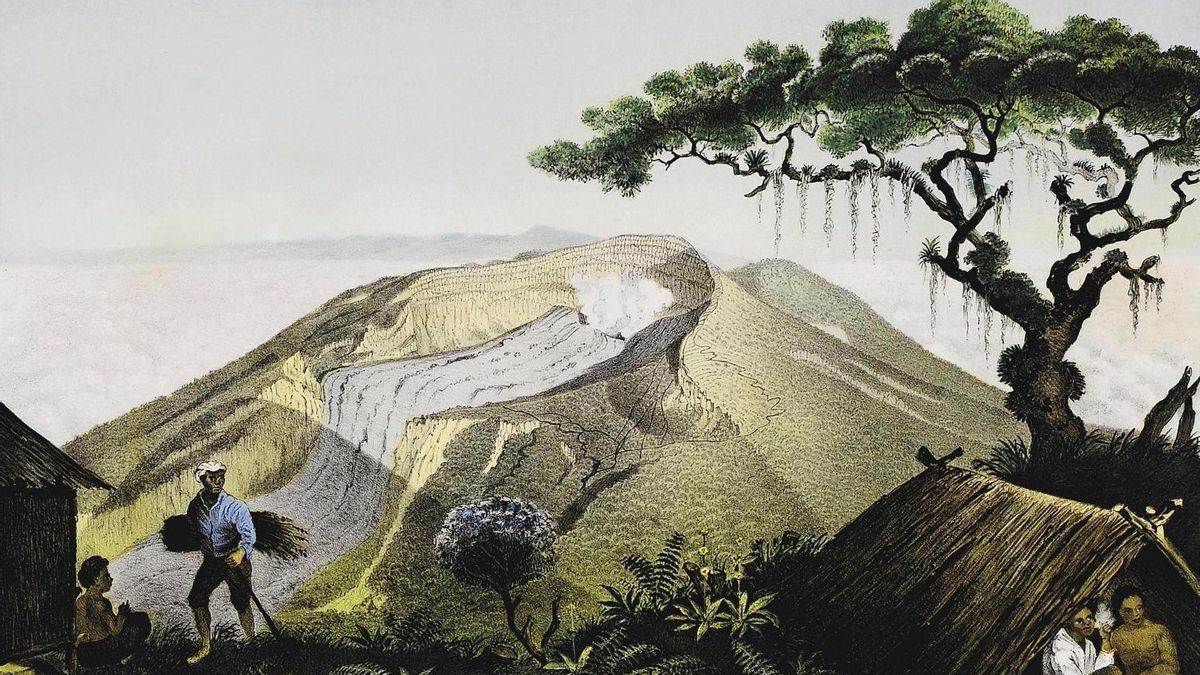
JAKARTA - Gede Pangrango is a mountain with a million charms. The main magnet lies on two mountain peaks: Puncak Gede and Puncak Pangrango. The allure then brought lovers of eastern exoticism from all over the country.
Thomas Stamford Raffles and Alfred Russel Wallace are some of them. For those who climb, and those who see from Batavia (Jakarta), the beauty of Gede Pangrango is simply amazing.
Behind it all, Gede Pangrango is also known as a sacred mountain. Mainly, because Gede Pangrango is referred to as "Bukit Agueng."
The existence of Mount Gede Pangrango is not only recorded in many Dutch documents. Gede Pangrango has been present in the ancient manuscript, Bujangga Manik from the 15th century.
In the manuscript, the Hindu traveler from Pakuan Padjadjaran, Bujangga Manik, tells that the ancient Sundanese people considered Gede Pangrango to be a sacred and sacred place. As a result, people around Pakuan know Gede Pangrango as Bukit Agueng, which means "Big Hill." Details Bujangga Manik wrote:
The length of the incline is ditedak, the river is dipped-peding. Sadatang aing ka Puncak, deuuk in na mu (ng) cal flat, teher ngahihidan crew. Tehran ne (n) jo mountain, that ta na Bukit Ageung, upstream wano na Pakuan. (The length of the incline I went through, I took it diligently. When I arrived at the Peak, I sat on a flat rock (flat) while fanning my body. Then I looked towards the mountain, that is Ageung Hill, the highest point in Pakuan.

The journey that Bujang Manik took was actually a pilgrimage. He traveled around the island of Java to Bali. Nevertheless, Bujang Manik looks like a modern traveler, enjoying natural panoramas and relaxing in many places.
Moreover, in the manuscript Bujang Manik contains a lot of information about the places he explored. Additional explanations, such as Mount Gede used to be Kabuyutan - a holy place - of the Pakuan Padjadjaran Kingdom (15-16th century), which is now Bogor, is the proof.
"If the identification is correct, in ancient Sundanese Mount Gede there must have been a large sacred building because of its status as a royal kabuyutan. It is also interesting to note that the phrase Sanghiang Talaga Warna can actually refer to a sacred building located in Telaga Warna. As it is known that the word sanghyang comes from the word sang + hyang and is commonly used as an article of sacred or holy things, "wrote Dani Sunjaya in the Purbawidya Journal entitled Mountains as Locations of Religious Sites and Scriptures for the Ancient Sundanese Period (2019). .
European naturalist climbing
[/ read_more]
Among the Europeans who had climbed Gede Pangrango, there was the name of Lieutenant Governor General of the Dutch East Indies, Thomas Stamford Raffles (1811-1816). Raffles is known to have climbed Gede Pangrango for the first time in mid-1815. The purpose of his ascent was to research medical plants in the Dutch East Indies.
While at the top, Raffles recorded the dynamics of temperature and immediately measured its altitude. Raffles' observations were then immortalized by his widow, Lady Sophia Raffles (Sophia Hull). Sophia rewrote Raffles' observations from a letter dated March 7, 1815.
At that time, Raflles sent the letter to his American naturalist colleague, Dr. Thomas Horsfield (1773-1859). It was also through this letter that Raffles joked that he was the first European to set foot on the top of Mount Gede.
“We have the broadest view at the top: the streets of Batavia. and we can see the southernmost coast of Sumatra, the waves on the south coast are visible to the naked eye, to the east we can see Indra Mayu and the Cheribon Hill which towers the highest there, "wrote Raffles quoted by Lady Sophia in the book Memoir of the Life and Public. Servicers of Sir Thomas Stamford Raffles (1830).
The contents of the letter confirm that Raffles was so amazed by the landscape he witnessed from the top of Mount Gede. Moreover, Raffles expressed his admiration for Gede Pangrango for Holsfield. Holsfield said Raffles, is a role model. In fact, after he was no longer active in the Dutch East Indies, the two of them were still in active contact by letter.
“In a personal letter from Hasting to Singapore dated 17 June 1819, Raffles reported on his meeting in Kolkata with two French naturalists, Pierre Diard and Alfred Duvaucel. Raffles invited them to accompany him to Bengkulu in the context of researching Sumatran fauna for the same reason as Dr. Horshield. This is because Horshield has conducted natural history research in Java, ”said John Bastin in the book Raffles and Hastings (2014).

After Raffles, there is the name of the famous British naturalist Alfred Russel Wallace who made the ascent to Gede Pangrango. While climbing to research flora and fauna, Wallace realized that the climb he made to the top of Panggerango and Gede was the most interesting event during his time in Java. Pangrango Peak, said Wallace, is a wavy plain and is bordered by low cliffs with a deep ravine.
However, while on the mountain, Wallace was unable to clearly see the view from the top of the mountain. The reasons include foggy and rainy weather. Even so, Wallace really enjoyed being there. Because the climb is able to map many types of plants and animals in Gede Pangrango.
“Even so, I really enjoyed my presence there, because for the first time I was in a quite high place on a mountain near the equator. I observe the transition of flora from hot regions to temperate regions, then make a brief note of these changes based on my research in Java, ”said Alfred Russel Wallace in his masterpiece Kepulauan Nusantara (2009).
[/ read_more]
The beauty of Gede Pangrango from Batavia
The traces of the beauty of Gede Pangrango are not only those who climb it. Those who see from afar too. Mainly, for those who live in Batavia. Information about the grandeur of Gede Pangrango was written by Sardadu Holland, HCC Clockener Brousson in the book Batavia Awal 20th Century (2004). According to him, the beauty of Gede Pangrango is best enjoyed in the morning from Gambir Field aka Koningsplein - now Monas.
“In the north, we can enjoy the breaking dawn. At that time oog van de dag which in Malay is called the sun, which is also called Italiaansch van het Oosten (Italian from the East) showed its first rays of waking up the coast. Meanwhile, the sun at the top of Mount Salak and Gede began to appear. Then the sun shone through the Koningsplein among the tall trees that were half asleep to usher in a new day, "said HCC Clockener Brousson.
An important figure in the writing of history in Jakarta, SJ Adolf Heuken confirmed this. Adolf said that in the past, from the Rijswijk Palace or the Governor-General's hotel - now the State Palace - the beautiful view of Mount Gede Pangrango can be seen with the naked eye. The reason is, because at that time the air was not very polluted.
The Europeans in Batavia really enjoyed the view of Gede Pangrango from Batavia. At sunrise, as well as when the sun is stretched. By looking at that view, they sometimes slide that there is no island as beautiful as the island of Java. Which is, rich in sunshine, beautiful mountains, and full of bright colors. Therefore, it is natural that Raffles' class in the masterpiece The History of Java (1817) reveals that Gede Pangrango is the mountain that most often enjoys its beauty from the streets of Batavia.
“The next mountain is Salak, whose eastern side is bordered by Mount Gede or Panarang'o, located 50 miles south of Batavia. These two mountains can be seen from the streets of Batavia, and based on their appearance, sailors used to call them blue mountains, "concluded Raffles.
MEMORY Other[/ read_more]
The English, Chinese, Japanese, Arabic, and French versions are automatically generated by the AI. So there may still be inaccuracies in translating, please always see Indonesian as our main language. (system supported by DigitalSiber.id)








